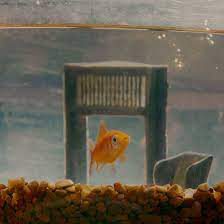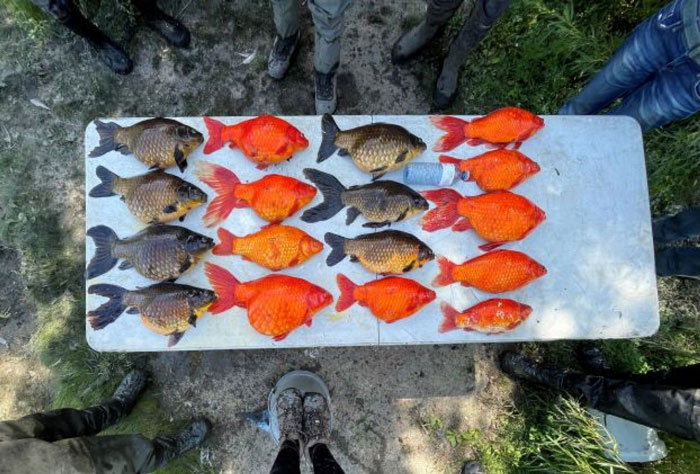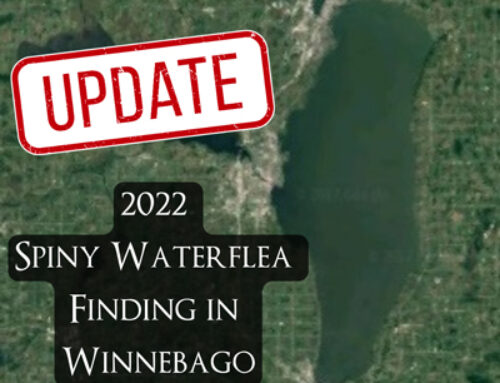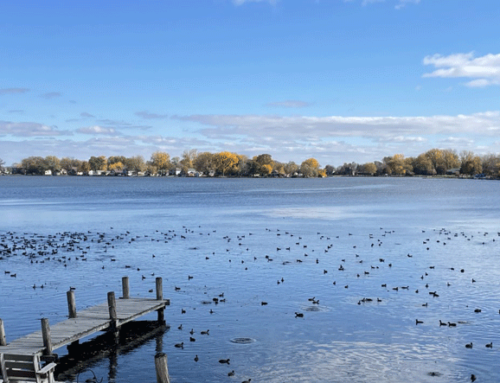Released Goldfish Grow to Monstrous Size, Destroy Habitat
Original Story: Livia Albeck-Ripka, The New York Times
Inside a fishbowl, the goldfish — a species of carp native to East Asia, bred for aesthetic delight and traditionally believed to bring good fortune — is hardly more than home décor. Usually just a few inches long, it is among the easiest of pets to keep.
But released into the wild, the seemingly humble goldfish, freed from glass boundaries and no longer limited to meager meals of flakes, can grow to monstrous proportions. They can even kill off native marine wildlife and help destroy fragile and economically valuable ecosystems.
“They can eat anything and everything,” said Christine Boston, an aquatic research biologist with Fisheries and Oceans Canada.
Over the past several years, Ms. Boston and her colleagues have been tracking invasive goldfish in Hamilton Harbour, which is on the western tip of Lake Ontario, about 35 miles southwest of Toronto. The bay has been decimated by industrial and urban development as well as by invasive species — making it among the most environmentally degraded areas of the Great Lakes.
Their study, published last month in the Journal of Great Lakes Research, could help pinpoint goldfish populations for culling, said Ms. Boston, who is the lead author. “We found out where they are before they start spawning,” she said. “That’s a good opportunity to get rid of them.”
The fast-growing female goldfish, Ms. Boston noted, can also reproduce several times in one season. “They have the resources,” she added, “and they can take advantage of them.”
 Goldfish were first spotted in Hamilton Harbour in the 1960s, but largely died off in the 1970s because of industrial contamination. In the early 2000s, their population appeared to recover. Goldfish can tolerate a wide range of water temperatures, reach sexual maturation quickly, and can eat nearly anything, including algae, aquatic plants, eggs and invertebrates, Ms. Boston said.
Goldfish were first spotted in Hamilton Harbour in the 1960s, but largely died off in the 1970s because of industrial contamination. In the early 2000s, their population appeared to recover. Goldfish can tolerate a wide range of water temperatures, reach sexual maturation quickly, and can eat nearly anything, including algae, aquatic plants, eggs and invertebrates, Ms. Boston said.
The feral goldfish are also destructive, uprooting and consuming plants that are home to native species. They help spawn harmful algal blooms by consuming the algae and expelling nutrients that promote its growth, Ms. Boston said, creating conditions that are intolerable to native fish.
To track the goldfish, the researchers captured and sedated 19 of the larger adults and surgically implanted tags the size of AA batteries into their bellies. The tags, which sent signals to acoustic receivers around the bay, provided researchers with a map of their locations.
Eight of the fish died, but the remaining 11 led Ms. Boston and her colleagues to find that the fish tended to spend the winter in deep waters and moved to shallower habitats by spring, where they prepared to spawn.
Some options for removing the goldfish, she said, include capturing them with specialized nets deployed beneath winter ice, or using “electro fishing,” which involves stunning the fish with an electrical current and scooping them from the water. Both techniques, she added, would avoid killing the native fish.
Nicholas Mandrak, a professor of biological sciences at the University of Toronto Scarborough, said that while goldfish were introduced to North America in the late 1800s, the wild population had begun to “dramatically increase” in the past two decades. Their spawning explosion, he said, resulted partly from people in densely-populated areas releasing pets in urban ponds.
Climate change may play a role, because of the goldfish’s capacity to adapt to warming and poorly oxygenated waters, he added.

“There are literally millions of goldfish in the Great Lakes, if not tens of millions,” Dr. Mandrak said.
Despite the threat, he added, environmental managers tend to forget the goldfish. “They just assume, ‘It’s been there for 150 years — there’s nothing we can do about it.’”
The problem is not unique to Canada. In Australia, a handful of unwanted pet goldfish and their offspring took over a river in the country’s southwest. Feral goldfish have flooded waterways in the United Kingdom, and, in Burnsville, Minn., the discovery of football-size creatures in a lake in 2021 led officials to beg their constituents: “Please don’t release your pet goldfish into ponds and lakes!”
People wrongly believe that because goldfish are “small and cute” they won’t pose a problem when released into the wild, said Dr. Ricciardi. “It’s the ‘Free Willy’ syndrome.”
Goldfish, he added, are just a small part of a vast invasion of non-native species whose outcomes can be unpredictable, and in some cases, are worsened by climate change.
“Under human influence, beasts are moving faster farther in greater numbers, reaching parts of the planet they could never reach before,” he said. “We’re talking about the redistribution of life on Earth.”
Anthony Ricciardi, a professor of invasion ecology at McGill University in Montreal, noted that not all invasive goldfish become supersized, but even the small ones are problematic, outpacing native fish populations and damaging the environment.
Their football-shaped bodies can swell to a size that makes them too large a meal for predators — up to about 16 inches long. “A fish would have to have a really big mouth to eat it,” she said.
Photo Credit: Vincent Tullo (New York Times), Fisheries and Oceans Canada, Great Lakes Laboratory for Fisheries and Aquatic Sciences
Questions? Comments? Contact Chris Acy, the AIS Coordinator covering Brown, Outagamie, Fond du Lac, Calumet, and Winnebago Counties at (920) 460-3674 or chris@fwwa.org!
Follow the Fox Wolf Watershed Alliance’s Winnebago Waterways Program on our Winnebago Waterways Facebook page or @WinnWaterways on X! You can also sign-up for email updates at WinnebagoWaterways.org.
Check out the Keepers of the Fox Program at https://fwwa.org/watershed-recovery/lower-fox-recovery/
Winnebago Waterways and Keepers of the Fox are Fox-Wolf Watershed Alliance programs. The Fox-Wolf Watershed Alliance is an independent nonprofit organization working to protect and restore water resources in the Fox-Wolf River Basin.
Reporting invasive species is a first step in containing their spread. Maintaining and restoring our waters and landscapes can reduce the impacts even when we don’t have other management options to an invasive species.





